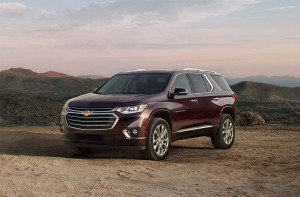
Strong SUV sales, like the Chevy Traverse, are helping to drive down the average fuel economy of new vehicles sold in the U.S.
The average fuel economy or window-sticker numbers for new vehicles sold in the U.S. in the U.S. in December slipped, dropping by 0.2 miles per gallon to 25.0 mpg from the revised value for November, according to numbers compiled by the University of Michigan Transportation Research Institute.
The drop reflected the rising proportion of light trucks versus passenger cars sold to consumers in the United States. The rise in sales of trucks and sport utility vehicles was offset somewhat by the increasing sales of battery electric and hybrid vehicles.
Overall, the average fuel economy of new vehicles sold in 2017 was 25.2 mpg, unchanged from 2016, according to UMTRI’s figures.
The fuel economy numbers for new vehicles sold in the U.S. during December was up 4.9 mpg since October 2007, the first month UMTRI researchers Michael Sivak and Brandon Schoettle compiled figures for the survey. The figures but down 0.5 mpg from the peak of 25.5 mpg reached in August 2014.
(Plug-in vehicle sales surpass 1M for the first time ever. Click Here for the story.)
The total number of light trucks sold in the United States rose 4.3% to about 10.90 million in 2017, while sales of passenger cars slumped about 11% to 6.3 million.
The latest report from UMTRI comes at a time when automakers have been pushing for a cut in the fuel efficiency standards for 2025, arguing that the target was difficult to achieve as consumers prefer larger, less efficient vehicles.
(Click Here for more about gas prices.)
The University of Michigan Eco-Driving Index or EDI —an index that estimates the average monthly emissions of greenhouse gases generated by an individual U.S. driver—was 0.83 in October 2017, unchanged from September 2017.
The EDI indicates that the average new-vehicle driver produced 17% lower emissions in October 2017 than in October 2007, but 5% higher emissions than the record low reached in November 2013.
(To see more about why premium gas is overrated, Click Here.)
The Obama administration finalized rules in 2012 to double the fleet-wide average fuel economy to 54.5 mpg by 2025, but the Environmental Protection Agency lowered it to 51.4 mpg based on rising number of trucks.
